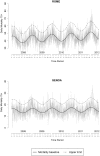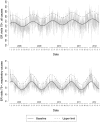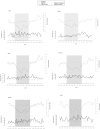The impact of the February 2012 cold spell on health in Italy using surveillance data
- PMID: 23637892
- PMCID: PMC3630119
- DOI: 10.1371/journal.pone.0061720
The impact of the February 2012 cold spell on health in Italy using surveillance data
Abstract
In February 2012 Italy was hit by an exceptional cold spell with extremely low temperatures and heavy snowfall. The aim of this work is to estimate the impact of the cold spell on health in the Italian cities using data from the rapid surveillance systems. In Italy, a national mortality surveillance system has been operational since 2004 in 34 cities for the rapid monitoring of daily mortality. Data from this system were used to evaluate the impact of the February 2012 cold spell on mortality shortly after the occurrence of the event. Furthermore, a cause-specific analysis was conducted in Roma using the Regional Mortality Registry and the emergency visits (ER) surveillance system. Cold spell episodes were defined as days when mean temperatures were below the 10(th) percentile of February distribution for more than three days. To estimate the impact of the cold spell, excess mortality was calculated as the difference between observed and daily expected values. An overall 1578 (+25%) excess deaths among the 75+ age group was recorded in the 14 cities that registered a cold spell in February 2012. A statistically significant excess in mortality was observed in several cities ranging from +22% in Bologna to +58% in Torino. Cause-specific analysis conducted in Roma showed a statistically significant excess in mortality among the 75+ age group for respiratory disease (+64%), COPD (+57%), cardiovascular disease +20% ischemic heart disease (14%) and other heart disease (+33%). Similar results were observed for ER visits. Surveillance systems need to become are a key component of prevention plans as they can help improve public health response and are a valid data source to rapidly quantify the impact on health. Cold-related mortality is still an important issue and should not be underestimated by public health Authorities.
Conflict of interest statement
Figures




Similar articles
-
The impact of the 2008 cold spell on mortality in Shanghai, China.Int J Biometeorol. 2013 Jan;57(1):179-84. doi: 10.1007/s00484-012-0545-7. Epub 2012 Apr 22. Int J Biometeorol. 2013. PMID: 22527759
-
Health impact of the 2008 cold spell on mortality in subtropical China: the climate and health impact national assessment study (CHINAs).Environ Health. 2014 Jul 24;13:60. doi: 10.1186/1476-069X-13-60. Environ Health. 2014. PMID: 25060645 Free PMC article.
-
The temporal variation in the effects of extreme temperature on respiratory mortality: Evidence from 136 cities in China, 2006-2019.Environ Int. 2024 Jul;189:108800. doi: 10.1016/j.envint.2024.108800. Epub 2024 Jun 3. Environ Int. 2024. PMID: 38850671
-
Part 2. Association of daily mortality with ambient air pollution, and effect modification by extremely high temperature in Wuhan, China.Res Rep Health Eff Inst. 2010 Nov;(154):91-217. Res Rep Health Eff Inst. 2010. PMID: 21446212
-
Cardiovascular mortality in winter.Arctic Med Res. 1995;54 Suppl 2:16-8. Arctic Med Res. 1995. PMID: 8900826 Review.
Cited by
-
Effects of Environmental and Socioeconomic Inequalities on Health Outcomes: A Multi-Region Time-Series Study.Int J Environ Res Public Health. 2022 Dec 9;19(24):16521. doi: 10.3390/ijerph192416521. Int J Environ Res Public Health. 2022. PMID: 36554402 Free PMC article.
-
The linkage among ambulance transports, death and climate parameters in Asahikawa City, Japan.Environ Health Prev Med. 2015 Jan;20(1):63-7. doi: 10.1007/s12199-014-0429-z. Epub 2014 Dec 3. Environ Health Prev Med. 2015. PMID: 25466262 Free PMC article.
-
Effect of cold spells and their modifiers on cardiovascular disease events: Evidence from two prospective studies.Int J Cardiol. 2016 Sep 1;218:275-283. doi: 10.1016/j.ijcard.2016.05.012. Epub 2016 May 13. Int J Cardiol. 2016. PMID: 27240151 Free PMC article.
-
Drivers of associations between daytime-nighttime compound temperature extremes and mortality in China.Commun Med (Lond). 2024 Jun 27;4(1):125. doi: 10.1038/s43856-024-00557-0. Commun Med (Lond). 2024. PMID: 38937621 Free PMC article.
-
Mortality Related to Chronic Obstructive Pulmonary Disease during the COVID-19 Pandemic: An Analysis of Multiple Causes of Death through Different Epidemic Waves in Veneto, Italy.Int J Environ Res Public Health. 2022 Oct 7;19(19):12844. doi: 10.3390/ijerph191912844. Int J Environ Res Public Health. 2022. PMID: 36232144 Free PMC article.
References
-
- WMO (2012) Cold spell in Europe and Asia in late winter 2011/2012. https://www.wmo.int/pages/mediacentre/news/documents/dwd_2012_report.pdf. Accessed 20 March 2013.
-
- Cox B, Wuillaume F, Van Oyen H, Maes S (2010) Monitoring of all-cause mortality in Belgium (Be-MOMO): a new and automated system for the early detection and quantification of the mortality impact of public health events. Int J Public Health 55 4: 251–9. - PubMed
-
- Rhea S, Ising A, Fleischauer AT, Deyneka L, Vaughan-Batten H, et al. (2012) Using near real-time morbidity data to identify heat-related illness prevention strategies in North Carolina. J Community Health 37 2: 495–500 doi:10.1007/s10900-011-9469-0. - DOI - PubMed
-
- Muscatello DJ, Churches T, Kaldor J, Zheng W, Chiu C, et al. (2005) An automated, broad-based, near real-time public health surveillance system using presentations to hospital Emergency Departments in New South Wales, Australia BMC Public Health. 5 141: doi:10.1186/1471-2458-5-141. - DOI - PMC - PubMed
-
- Josseran L, Caillère N, Brun-Ney D, Rottner J, Filleul L, et al. (2009) Syndromic surveillance and heat wave morbidity: a pilot studybased on emergency departments in France. PBMC Medical Informatics and Decision Making 2009 9: 14 doi:10.1186/1472-6947-9-14. - DOI - PMC - PubMed
Publication types
MeSH terms
LinkOut - more resources
Full Text Sources
Other Literature Sources

